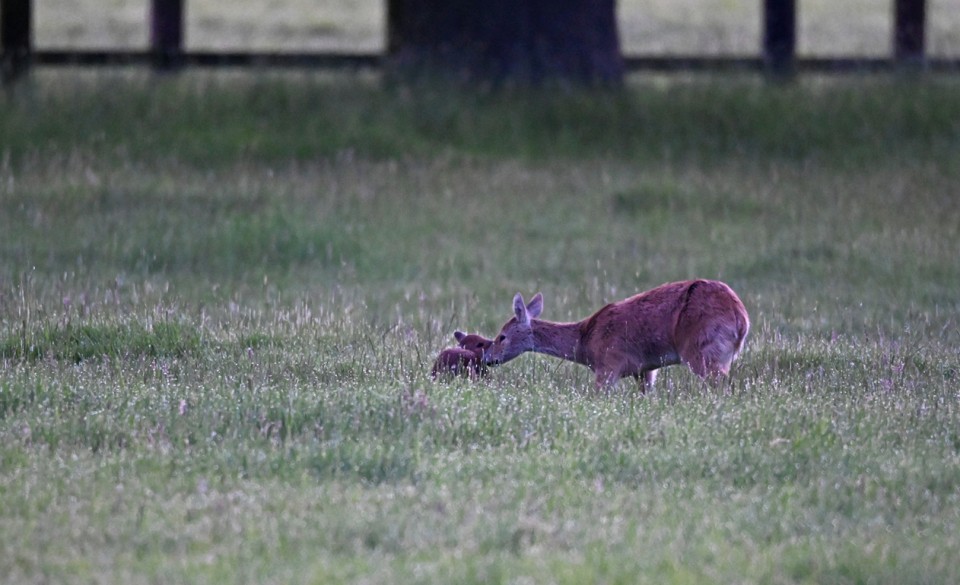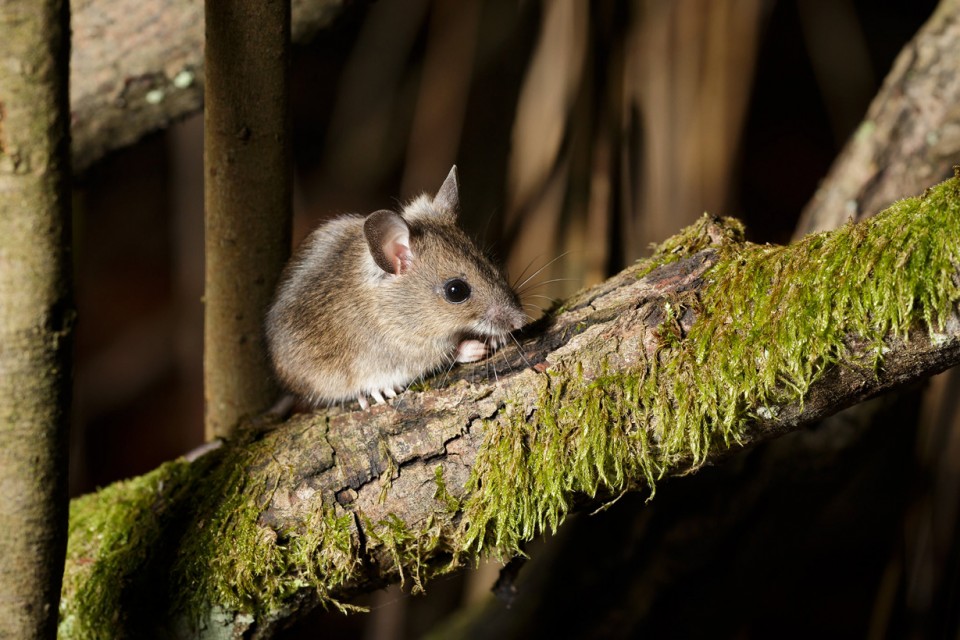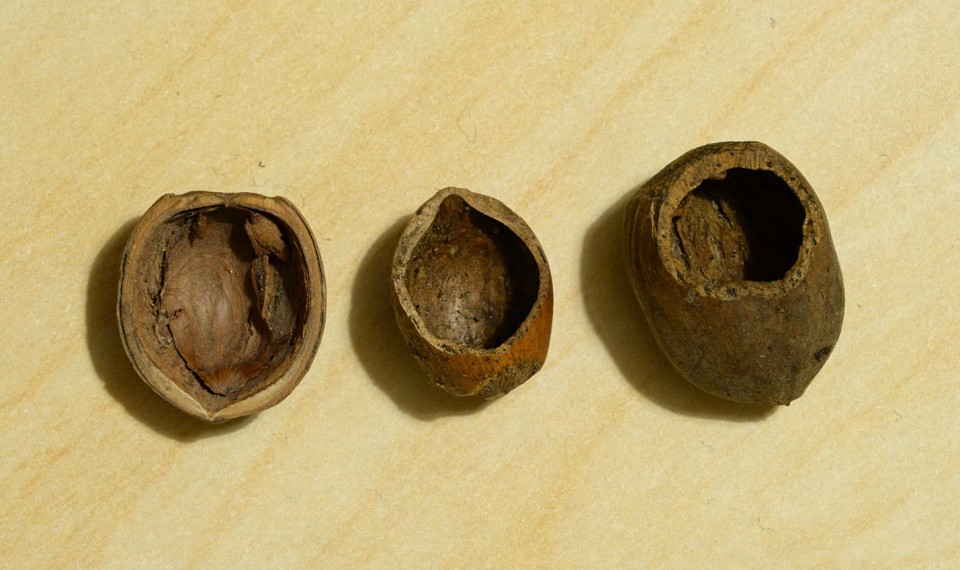
Welcome to the end of autumn (or spring if you're in the southern hemisphere) and the penultimate month of 2023. Formerly the ninth month of the year, when Britain adhered to the calendar of Romulus, the month retains the name -- novem being the Latin for "nine". As autumn draws to a close, November tends to be our stormiest month, with a high chance of low-pressure systems bringing both wind and rain to most of the UK. Indeed, it's during autumn that the jet stream, that fast moving ribbon of air about six miles up, starts powering up. The stream is driven by the temperature contrast between the poles and equator and the bigger the contrast the faster the airflow, hence it speeds up as the northern hemisphere enters winter. November can also be a very cold month, and we do sometimes see low temperatures and even heavy snowfall; November 2010 was the most recent, with the mercury dropping to -18C (-0.4F) in Wales at the end of the month.
November is the end of the pannage season here in the New Forest, where pigs are let out into the woodlands to eat acorn and beech mast - if you're interested in finding out more, check out my article on the common of mast.
Website news
Not much has happened website-wise over the past few weeks, but there are now a couple of new sections of the water deer article online, dealing with fawn care (grooming and weaning) and fawn survival.

Weather Update
October started with some showers in northwest and southern areas, but most places remained dry with sunny spells. It was also unseasonably mild, particularly in the south-east, and this lasted for the first two weeks even as cloud and patchy rain spread eastward across central areas. The first week was generally a mix of sunny spells and showers, accompanied by gusty winds; the second was more settled, with temperatures widely in high teens or low 20s Celsius. Temperatures dropped dramatically around the middle of the month, and we saw overnight lows in low single figure Celsius here on the south coast and sub-zero further north. The cold didn't last long, however, and after a couple of days a deep low pressure brought wet and windy conditions across England and overnight lows of an exceptionally mild 17C (63F).

The penultimate week of last month saw two storm systems move across the country, bringing wind and some torrential rain, particularly to northern England and Scotland. Indeed, storm "Babet" dropped a month's worth of rain on parts of England and Scotland, with the Isle of Wight, north-east England and Scotland particularly badly hit, towards the end of the third week, causing widespread flooding and the death of at least one person. The month ended on a showery note, with heavier rain in northern England and Scotland, and temperatures about average by day but slightly above average by night.
Outside of the UK, Mexico experienced record October heat with 44C (111F) in Hermosillo and temperatures in the low 40s quite widely. Anomalies were also logged in the western USA during the third week, with 40.6C (105F) at Ogilby in California. Canada experienced a very warm October, with the first cold weather only arriving during the third week. Temperatures also rose to 39.1C (102F) at Kairouan in Tunisia, and 37C (99F) at Torregrotta in Sicily as the Mediterranean experienced an autumn warm spell. Tragically, a small but very powerful tropical cyclone (hurricane "Otis") underwent explosive intensification to a category five storm and made landfall in southern Mexico on the 25th, bringing 165 mph (270 kmph) winds, a storm surge and torrential rain that claimed at least 27 lives.
News and discoveries
Dingo domestication. We have a reasonable picture of the process and timescales for domestication of the wolf into the pooch with which so many of us share our homes, the earliest evidence coming from Germany nearly 15,000 years ago. New data have now added to the story of wild dog domestication, suggesting that early settlers in Australia may have attempted to domesticate dingoes. Researchers studying remains at the Curracurrang archaeological site near Sydney found dingoes buried with extreme care alongside First Nations people that radiocarbon dating suggests died some 2,000 years ago.

Plunging protection. Kingfishers are renowned for their diving abilities and, while not all the 34 species in the Alcedininae subfamily eat fish, they can dive at considerable speed to catch their prey. Recently, researchers looked at the genome of 30 kingfisher species to try and identify whether there were any coevolved traits between their diet and morphology to protect their brains against the impact of hitting water at high speed. Several genes were identified that were associated both with a fish-based diet and brain structure, including mutations in the MAPT gene that codes for tau proteins which influence feeding behaviour and help stabilise tiny structures inside the brain. MAPT is also thought to help woodpeckers avoid concussion.
Heat hazard. Most of us are aware that global temperatures are increasing, and whether you consider it to be natural, anthropogenic or a combination of both, the consequences will be felt by human and non-human life in the coming years and decades. New data from a team at University of California, Davis, suggest that farmland birds may be particularly badly impacted. Using data from the Project Nest Watch citizen science program, the scientists were able to assess trends in nesting success continent-wide based on some 60 species. All species were vulnerable to heatwaves in agricultural landscapes, with those building open cup nests at the highest risk. The models pointed to an additional 5% decline in nesting success by 2100 under current greenhouse gas emission trajectories.
Biodegradable blandishments? Plastic is a huge environmental issue, with only about 9% of the 7 billion tonnes of plastic waste generated annually being recycled, and less than 1% recycled more than once. The result is 8 tonnes of plastic waste making it into the oceans in 2015 alone, according to one recent assessment. Biodegradable plastic, that which breaks down to components found in nature within a "reasonable time frame", has been widely touted as part of the solution, but recent data suggest that claims have been exaggerated. Now a new study published in Science of the Total Environment reports that exposure to the biopolymers in biodegradable plastics detrimentally impacts the escape performance, routine swimming and aerobic metabolism of wild fish.
Seasonal highlight – the wood mouse (Apodemus sylvaticus)
November is the month that I start keeping an eye on the bird food in the shed, because the bags tend to start developing holes in them and the contents mysteriously vanish. The first time this happened I was somewhat bemused when, a few days later, I moved some paint cans and found a pile of peanuts hidden among them. I'd discovered a cache, and with a bit of detective work (including a few unsuccessful placements of the trailcam) I established the culprit was a small rodent: a wood mouse. Wood mice are relatively common garden visitors, although they often go unnoticed by their human neighbours because much of their activity is conducted under the cover of darkness. Autumn and winter are nonetheless a great time to try and spot these rodents because it's the time of year females tend to disperse and both sexes are actively caching food.

A mouse by any other name
Most people can recognise a mouse, and in the UK we have three species of primarily 'outdoor' mice: the harvest mouse (Micromys minutes); the yellow-necked mouse (Apodemus flavicollis); and the ubiquitous wood mouse (Apodemus sylvaicus). According to Stefan Buczacki, in his 2002 opus Fauna Britannica, the word 'mouse' is an ancient one:
"It reached modern English from Old English but has a pedigree extending back through Latin and Greek to Sanskrit [a sacred Hindu language dating back to the mid-to-late second millennium BCE]. It is said to have originally meant 'thief', its Sanskrit roots having to do with stealing."
Mice are classed as mammals and sit within a large super-family called the Muroidea, which contains the mice, rats, dormice, voles, lemmings, muskrats, gerbils and hamsters. Within the Muroidea sits the family Muridae, which is not only the largest rodent family, but also the largest mammalian family, with more than 700 species. Within the Muridae are five subfamilies that split the hamsters and gerbils and a few other highly specialised mice away from the rest, and it's the Murinae that we're interested in here, because this is where we find Apodemus (collectively referred to as the Eurasian field mice), along with 131 other genera. Based on a genetic analysis published back in 2005 there are currently 21 species of field mouse, including the wood mouse. For many years, the wood mouse and the very similar-looking (and closely related) yellow-necked mouse were believed to be the same species. A careful study of wood mice, published by William de Winton in 1894, however, noted that some were slightly smaller and less boldly coloured than others, with a striking band of yellow fur around their neck; these were split out from the familiar wood mice and reclassified as yellow-necked mice. Incidentally, some references list 1894 as the introduction of the yellow-necked mouse into Britain, when in fact it marked their separation from the wood mouse.

The wood mouse's binomial name, Apodemus sylvaticus, is derived from the Greek apodēmos, meaning 'away from the house' -- to differentiate it from the house mouse, even though this species does sometimes enter houses -- and sylvaticus, which is Latin for 'of the woods', but when applied to plants and animals it actually infers 'of the wild'.
One small step for a mouse, one giant leap...
Wood mice grow to between about 8cm and 11cm (3-4 in.), with a tail as long (in some cases, slightly longer) as the body and little difference in size between males and females. The fur is dark brown on the back, merging imperceptibly to a paler -- almost yellow-brown -- hue on the flanks and a white belly. The large eyes, large ears and long hind feet (the latter measuring 2-2.5cm, about an inch), as well as their fur colour, distinguish this species from the house mouse (which are a buff-grey in colour). Wood mice weigh in at 13-27 grams (between half and one ounce), although heavily pregnant females may exceed 30g (1 oz.).
These endearing small mammals are highly adaptable and can be found in a wide range of habitats, including woodland, arable land, gardens (even a small garden in the middle of a big city, such as mine), parkland, bramble and bracken scrub, and on sand dunes. They're sometimes found in heather moorland, particularly where short-tailed voles are absent, but are rarely found on high moors and scree, unless there are stone walls and buildings to provide some cover. Within these habitats, wood mice can range over considerable areas, although the size of their home range varies with habitat and sex.

Home ranges are generally larger in arable fields and on sand dunes than in woodland, which reflects the greater density and more predictable distribution of food in the latter. Similarly, males tend to be more active than females and range over larger areas. In woodland, for example, the average home range of a female is just under two kilometres (half an acre), while a male can range over three times that. In sand dune habitats, by contrast, males and females may range over 37 km and 16 km (9 and 4 acres), respectively. Despite their small size, both sexes can move two kilometres (just over one mile) or more in a single night looking for food and/or mates. A fascinating paper to the journal BMC Ecology back in 2003 by Oxford University zoologists Pavel Stopka and David Macdonald found that, while out exploring, wood mice place leaves, twigs and other conspicuous objects around to use as way markers, highlighting sites of interest. The biologists suggest that leaving such objects to mark out a spot is less risky than leaving a scent mark, which might be detected by a predator.
Wood mice maintain reasonably good mental maps of their environment and their ranges relative to their neighbours'. A study published in 1951 reported that mice in Dorset always found their way back on to their home range when moved 400 yards (365m) away, but only half returned when deposited 725 yards (663m) away. These rodents are generally extremely timid and can be very difficult to approach, owing to their excellent vision, sense of smell (they can identify other mice from the smell of their urine or scent marks alone) and sensitivity to vibration. This is unsurprising, given that they are food for a wide range of predators including cats, foxes, badgers, kestrels, stoats, weasels and owls, of which the tawny owl is probably the most significant; some studies suggest that 30% of a woodland tawny's diet is wood mice.
Wood mice are generally quite sociable small mammals and, although females will defend exclusive breeding territories (a small 'core' of their home range from which they will expel interlopers), males overlap in their home ranges and communal nests form during the winter, with mice of both sexes. That said, males tend to be more aggressive during the spring when the breeding season gets underway, and females are most aggressive while they're lactating. Most studies on aggression in this species come from captive individuals, while those in the wild tend merely to avoid one another, making such aggression comparatively rare.
These mice are primarily nocturnal, with a peak of activity at dawn and dusk at this time of year and throughout the winter. They are less active on moonlit nights, when predators find it easier to spot them, and during periods of very inclement weather. While moving around their home ranges, wood mice use a complex system of underground and 'litter zone' (i.e., within the leaf litter and deep within long grass, but not below the soil) tunnels and above-ground feeding stations. During periods of heavy snow cover, wood mice remain active in the subnivean zone, moving around in a series of tunnels and pockets under the snow. They feed out in the open more commonly than voles tend to, particularly under bird feeders in gardens and on nature reserves. In more wooded habitat, food will be carried into a sheltered spot (frequently under a log, or among bramble) where it is consumed. Disused bird nests are sometimes also used as feeding platforms and can become littered with discarded nut and seed shells. Nests are built below ground -- usually from finely shredded leaves, moss and grass -- and used for resting and breeding, with chambers for the caching (storage) of food. Indeed, wood mice do not hibernate during the winter (although they may undergo brief periods of torpor if it gets very cold) and rely on food that was found and cached during the autumn.

Feeding and breeding
The diet of the wood mouse is heavily influenced by season and habitat but nuts and seeds predominate. In autumn and winter, tree seeds such as hazel and beech are commonly taken by these mice, and hazel nuts are frequently found in caches. They will also feed, to a lesser extent, on buds, fruit, fungi, moss and galls, as well as taking some animal prey in the form of insects, spiders, snails, earthworms, centipedes and larval butterflies and moths. A study published in the late 1950s reported that males ate more insects and less greenery than females, while younger mice ate fewer insects and more buds and fungi than adults. (I would caution against reading too much into these figures because this is a highly opportunistic species, with diet varying considerably with habitat. The results for the young mice may reflect that they aren't yet skilled enough to catch insects or find buds and fungi easier to tackle than nuts.) In gardens, wood mice will readily accept sunflower seeds, peanuts and mixed bird seed.
In some populations, wood mice will breed throughout the year but, more typically, the breeding season runs from March to October. The first pregnancies are evident by April, peaking during July and August and tailing off by the autumn. Wood mice gestate for about three weeks (19-20 days), although if the female is still lactating when she conceives (some females can produce six litters in a year) a period of delayed implantation may follow, which extends the gestation by up to 10 days. These mice are promiscuous and DNA studies in captive animals revealed 85% of litters were of mixed paternity, with some having four different fathers.
Male wood mice are apparently unique among mammals in that their sperm are cooperative (even altruistic). In a fascinating paper to the journal Nature in 2002, University of Sheffield biologist Harry Moore and colleagues report that the sperm of wood mice use special hooks to join together to form long chains of hundreds or thousands of sperm cells inside the uterus. This sperm 'train', which is often composed of a mixture of sperm from different males, can swim much faster than any of the individual sperm, meaning it can get to the egg easier and more quickly. It's not entirely clear how this evolved, but the leading theory is that the cells engage in what's called the "green beard" effect. Essentially, the sperm can detect which others are most similar (genetically) to themselves and hook up with them, because they're likely to be either from the same, or a closely related, male.

Litters generally contain between four and seven pups, although up to nine in a single litter have been recorded, each weighing about a gram, blind and furless - a buff-grey fur (like that of the house mouse) starts growing shortly after birth. The pups are weaned at between 18 and 22 days old and, they start leaving the nest shortly before this (15-16 days old, weighing about 6 grams / 0.2 oz.). During their development, the female alone cares for them. Early born litters will breed in the summer of their first year, while those born later will breed during the following spring.
Wood mice are relatively short-lived mammals, with few adults surviving from one summer to the next; many die during the spring having lost so much weight over the winter. The maximum life span is generally considered to be about 20 months, although in captivity they can live for considerably longer. The current record is held by a wood mouse kept at the University of Erlangen-Nuremberg in Germany, which died in August 1955, having lived there for almost six years; it was an adult when it arrived and was estimated to be six years and four months old when it died.
At this time of year, it is estimated that Britain is home to 114 million wood mice. Winter and early spring losses then reduce the population to 38 million.
There's a mouse, loose, about this...garden
So, when you're out and about, what should you be looking for to know whether there are wood mice in the area? Well, checking in crevices and hollows for discarded nuts and seeds is a good start. Wood mice feed by holding the nut against the ground and gnawing into (usually) the top with their lower teeth, working away at the side furthest from the body. The lower teeth work against the upper incisors, which grip the nut on the outside rim. The result is that a rather irregular hole is gnawed into the nut, which has a very distinct corrugated edge to it, because the teeth scrape at 90-degrees to the edge of the hole; chip marks caused by the upper incisors can be seen around the outside of the hole. The mouse is after the kernel inside the shell and will chip it out through the hole it gnaws in the outer shell.

Wood mice will also extract seeds from pinecones, leaving a similar field sign to those left by squirrels. One significant difference, however, is that a wood mouse will drag their cones into cover, so they can feed away from the prying eyes of predators. Consequently, the remains of these cones tend to be found in undergrowth in small piles. The cones themselves have had most of the scales removed (except for the bunch at the top, which contain very few seeds and don't warrant the effort), leaving a smooth shaft with no ragged or frayed ends. Wood mice will also eat fruit, such as blackberries, but tend to eat only the seeds, leaving the flesh behind. It is also worth searching long grass for tunnel networks, ending in holes in the earth typically less than 3cm (1 in) in diameter. It is almost impossible to determine whether the run belongs to a shrew, vole or mouse just by looking at it, but this can often be solved by sitting and waiting as it gets dark, with a red-filtered torch.
For a round-up of Britain's seasonal wildlife highlights for late autumn, check out my Wildlife Watching - November blog.